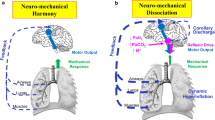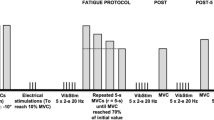Abstract
Purpose
Surprisingly, the activation characteristics of the neck inspiratory muscles as a function of key inspiratory mechanical parameters have yet to be demonstrated experimentally under well-controlled conditions. This study aimed to elucidate the muscle activation patterns of the neck inspiratory muscles by strictly controlling flow rate and lung volume.
Methods
Thirteen healthy subjects matched their inspiratory flow rate at approximately 20–100% of peak flow rate (PFR) as steady as possible during inspiration. Amplitude of surface electromyogram (EMG) of the sternocleidomastoid (SCM) and scalene were calculated for every increase in %PFR over a duration corresponding to an increase in lung volume by 10% of forced vital capacity (FVC), as well as for every 5% increment of FVC over a point corresponding to an increase in flow rate by 20%PFR to determine the %PFR–EMG and %FVC–EMG relations, respectively.
Results
Regression analyses showed that EMGs of the neck inspiratory muscles exponentially increased with increase in %PFR and their associated variables which reflect recruitment onset when increasing flow rate increased with increasing %FVC. In %FVC–EMG relation, a linear regression analysis showed positive slope at all %PFR and positive y-intercept at 80% PFR.
Conclusions
The main new finding is that the neck inspiratory muscle activities increase with flow rate as well as lung volume. The positive y-intercept of the %FVC–EMG relation at higher %PFR indicates that the neck inspiratory muscles are always activated even when lung volume level is low, implying that SCM is not necessarily an “accessory” muscle as described in previous observations.






Similar content being viewed by others
Abbreviations
- AEMG:
-
Averaged value of low-pass filtered-rectified electromyogram
- COPD:
-
Chronic obstructive pulmonary disease
- EMG:
-
Electromyogram
- FVC:
-
Forced vital capacity
- MIP:
-
Maximal inspiratory pressure
- MU:
-
Motor unit
- PFR:
-
Peak flow rate
- SC:
-
Scalene
- SCM:
-
Sternocleidomastoid
References
Breslin EH, Garoutte BC, Kohlman-Carrieri V, Celli BR (1990) Correlations between dyspnea, diaphragm and sternomastoid recruitment during inspiratory resistance breathing in normal subjects. Chest 98:298–302
Butler JE, McKenzie DK, Crawford MR, Gandevia SC (1995) Role of airway receptors in the reflex responses of human inspiratory muscles to airway occlusion. J Physiol 487(Pt 1):273–281
Campbell EJM (1955) The role of the scalene and sternomastoid muscles in breathing in normal subjects; an electromyographic study. J Anat 89:378–386
Chiti L, Biondi G, Morelot-Panzini C, Raux M, Similowski T, Hug F (2008) Scalene muscle activity during progressive inspiratory loading under pressure support ventilation in normal humans. Respir Physiol Neurobiol 164:441–448
Cvetko E, Karen P, Eržen I (2012) Myosin heavy chain composition of the human sternocleidomastoid muscle. Ann Anat 194:467–472
De Troyer A, Estenne M (1984) Coordination between rib cage muscles and diaphragm during quiet breathing in humans. J Appl Physiol 57:899–906
De Troyer A, Kirkwood PA, Wilson TA (2005) Respiratory action of the intercostal muscles. Physiol Rev 85:717–756
Del Balso C, Cafarelli E (2007) Adaptations in the activation of human skeletal muscle induced by short-term isometric resistance training. J Appl Physiol 103:402–411
Dimitriadis Z, Kapreli E, Konstantinidou I, Oldham J, Strimpakos N (2011) Test/retest reliability of maximum mouth pressure measurements with the MicroRPM in healthy volunteers. Respir Care 56:776–782
Farina D, Merletti R, Enoka RM (2004) The extraction of neural strategies from the surface EMG. J Appl Physiol 96:1486–1495
Fuglevand AJ, Winter DA, Patla AE (1993) Models of recruitment and rate coding organization in motor-unit pools. J Neurophysiol 70:2470–2488
Gandevia SC, Leeper JB, McKenzie DK, De Troyer A (1996) Discharge frequencies of parasternal intercostal and scalene motor units during breathing in normal and COPD subjects. Am J Respir Crit Care Med 153:622–628
Gosselink R, De Vos J, van den Heuvel SP, Segers J, Decramer M, Kwakkel G (2011) Impact of inspiratory muscle training in patients with COPD: what is the evidence? Eur Respir J 37:416–425
Harms CA, Wetter TJ, St Croix CM, Pegelow DF, Dempsey JA (2000) Effects of respiratory muscle work on exercise performance. J Appl Physiol 89:131–138
Henneman E, Somjen G, Carpenter DO (1965) Functional significance of cell size in spinal motoneurons. J Neurophysiol 28:560–580
Hudson AL, Gandevia SC, Butler JE (2007) The effect of lung volume on the co-ordinated recruitment of scalene and sternomastoid muscles in humans. J Physiol 584:261–270
Hudson AL, Joulia F, Butler AA, Fitzpatrick RC, Gandevia SC, Butler JE (2016) Activation of human inspiratory muscles in an upside-down posture. Respir Physiol Neurobiol 226:152–159
Johnson MA, Polgar J, Weightman D, Appleton D (1973) Data on the distribution of fibre types in thirty-six human muscles: an autopsy study. J Neurol Sci 18:111–129
Koh TJ, Grabiner MD (1993) Evaluation of methods to minimize cross talk in surface electromyography. J Biomech 26:151–157
Koppers RJH, Vos PJE, Boot CRL, Folgering HTM (2006) Exercise performance improves in patients with COPD due to respiratory muscle endurance training. Chest 129:886–892
Kubota M, Kobayashi H, Quanjer PH, Omori H, Tatsumi K, Kanazawa M (2014) Reference values for spirometry, including vital capacity, in Japanese adults calculated with the LMS method and compared with previous values. Respir Investig 52:242–250
Lawrence JH, De Luca CJ (1983) Myoelectric signal versus force relationship in different human muscles. J Appl Physiol 54:1653–1659
Legrand A, Schneider E, Gevenois P, De Troyer A (2003) Respiratory effects of the scalene and sternomastoid muscles in humans. J Appl Physiol 94:1467–1472
Lötters F, van Tol B, Kwakkel G, Gosselink R (2002) Effects of controlled inspiratory muscle training in patients with COPD: a meta-analysis. Eur Respir J 20:570–576
Luo Y, Hart N, Mustfa N, Lyall R, Polkey M, Moxham J (2001) Effect of diaphragm fatigue on neural respiratory drive. J Appl Physiol 90:1691–1699
Masubuchi Y, Abe T, Yokoba M, Yamada T, Katagiri M, Tomita T (2001) Relation between neck accessory inspiratory muscle electromyographic activity and lung volume (Abstract). Nihon Kokyuki Gakkai Zasshi 39:244–249
Mckenzie DK, Butler JE, Gandevia SC (2009) Respiratory muscle function and activation in chronic obstructive pulmonary disease. J Appl Physiol 107:621–629
Mizuno M (1991) Human respiratory muscles: fibre morphology and capillary supply. Eur Respir J 4:587–601
Nardone A, Schieppati M, Umana F (1988) Shift of activity from slow to fast muscle during voluntary lengthening contractions of the triceps surae muscles in humans. J Physiol 395:363–381
O’Donnell DE (2006) Impacting patient-centred outcomes in COPD: breathlessness and exercise tolerance. Eur Respir Rev 15:37–41
Quon BS, Wilkie SS, Molgat-Seon Y, Schaeffer MR, Ramsook AH, Wilcox PG, Guenette JA (2015) Cardiorespiratory and sensory responses to exercise in adults with mild cystic fibrosis. J Appl Physiol 119:1289–1296
Raper AJ, Thompson WT, Shapiro W, Patterson JL (1966) Scalene and sternomastoid muscle function. J Appl Physiol 21:497–502
Ratnovsky A, Elad D, Halpern P (2008) Mechanics of respiratory muscles. Respir Physiol Neurobiol 163:82–89
Shadgan B, Guenette JA, Sheel AW, Reid WD (2011) Sternocleidomastoid muscle deoxygenation in response to incremental inspiratory threshold loading measured by near infrared spectroscopy. Respir Physiol Neurobiol 178:202–209
Tanner DA, Duke JW, Stager JM (2014) Ventilatory patterns differ between maximal running and cycling. Respir Physiol Neurobiol 191:9–16
Tayashiki K, Takai Y, Maeo S, Kanehisa H (2016) Intra-abdominal pressure and trunk muscular activities during abdominal bracing and hollowing. Int J Sports Med 37:134–143
Van Cutsem M, Duchateau J, Hainaut K (1998) Changes in single motor unit behaviour contribute to the increase in contraction speed after dynamic training in humans. J Physiol 513:295–305
Ward ME, Eidelman D, Stubbing DG, Bellemare F, Macklem PT (1988) Respiratory sensation and pattern of respiratory muscle activation during diaphragm fatigue. J Appl Physiol 65:2181–2189
Wen AS, Woo MS, Keens TG (1997) How many maneuvers are required to measure maximal inspiratory pressure accurately? Chest 111:802–807
Wood J, Biagland-Ritchie B (1983) Linear and non-linear surface EMG/force relationships in human muscles: an anatomical/functional argument for the existence of both. Am J Phys Med 62:287–299
Yokoba M, Abe T, Katagiri M, Tomita T, Easton PA (2003) Respiratory muscle electromyogram and mouth pressure during isometric contraction. Respir Physiol Neurobiol 137:51–60
Yoshitake Y, Shinohara M, Kouzaki M, Fukunaga T (2004) Fluctuations in plantar flexion force are reduced after prolonged tendon vibration. J Appl Physiol 97:2090–2097
Yoshitake Y, Takai Y, Kanehisa H, Shinohara M (2014) Muscle shear modulus measured with ultrasound shear-wave elastography across a wide range of contraction intensity. Muscle Nerve 50:103–113
Acknowledgements
The authors would like to thank Dr. Naokazu Miyamoto (National Institute of Fitness and Sports in Kanoya) for helpful suggestions. We thank Mr. Garrett Jones (National Institute of Fitness and Sports in Kanoya) for helping in proofreading and improving the manuscript. We also thank Mr. Hironori Watanabe and Mr. Shobu Kurohara (National Institute of Fitness and Sports in Kanoya) for assistance with the experiment. This study was funded, in part, by the Grant-in-Aid for “Challenging Exploratory Research” in Japan (16K13000) and by the KAWAI Foundation for Sound Technology and Music to YY.
Author information
Authors and Affiliations
Corresponding author
Ethics declarations
Conflict of interest
The authors declare that they have no conflict of interest.
Additional information
Communicated by Susan Hopkins.
Rights and permissions
About this article
Cite this article
Washino, S., Kanehisa, H. & Yoshitake, Y. Neck inspiratory muscle activation patterns during well-controlled inspiration. Eur J Appl Physiol 117, 2085–2097 (2017). https://doi.org/10.1007/s00421-017-3699-5
Received:
Accepted:
Published:
Issue Date:
DOI: https://doi.org/10.1007/s00421-017-3699-5




